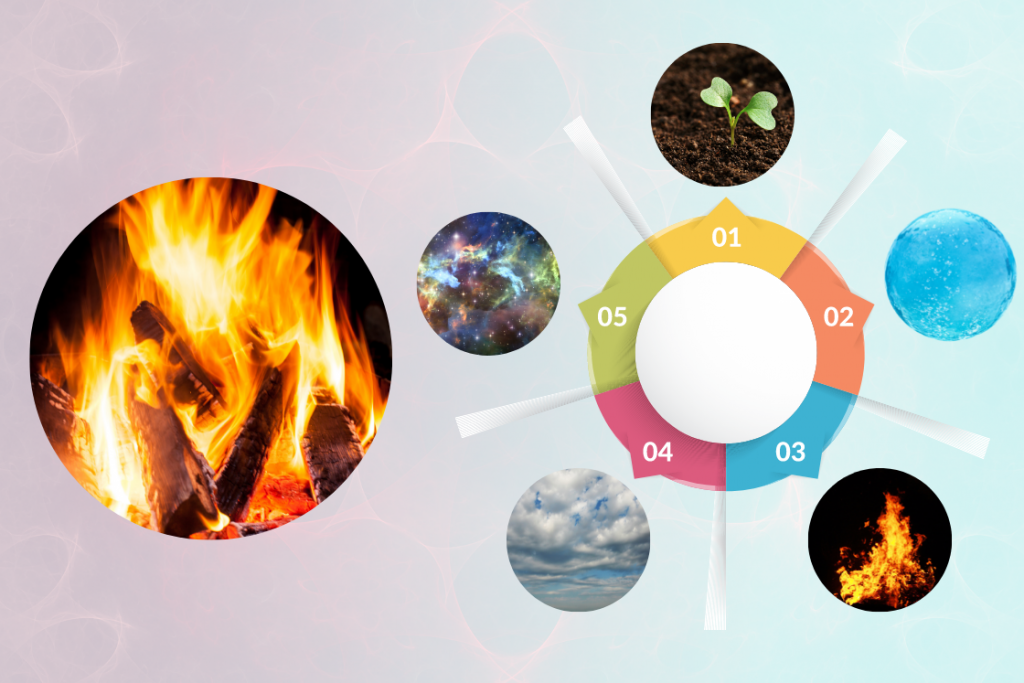- Symbolism
- Ayurveda
- TCM
- Spiritual context
- Functions
- Excess of fire element
- Deficiency of fire element
- Practices to Balance

Energy, heat, passion, fiery, hot, anger are some of the common emotions or words that come up when you hear the word ‘fire’. And these are some of the characteristics of the fire element.
It said that fire was the first element created on earth and humans have been benefited from it ever since they discovered it.
In Sanskrit, the fire element is called Tejas and it comes third in the order of Pancha tattva or the five elements of the body. Fire is evolved from ether and air, where ether gives the space for it to exist and air gives the momentum or capacity to burn.
Within the body, it is in the form of heat that gives us energy. And in its physical state, you can see it in the form of fire, sun, light, or in the form of energy such as solar, hydroelectric, nuclear, fossil fuel, and bio-diesel.
Hot, light, dry, rough, subtle, flowing, sharp, clear and soft are some qualities of the fire element. As it is warm and powerful, it is also linked with masculine energy.
By tapping into its power, we can bring about a transformation within ourselves and works towards better mental and physical well-being.
The symbolism of Fire Element
When we say that fire is one of the elements that make up our body composition, this means it is present in the form of heat and gastric juices in the stomach. This is why having proper digestion is key to gaining energy and providing important nutrients to all parts of the body.
The fire element is seen as a symbol of love, desire, anger, power, strength, assertiveness, light, and energy. It is also seen as a symbol of transformation, how it changes food into an energy source, ideas into action, and offerings made into the spiritual fire into smoke.
Let us have a look at other symbolic meanings of the fire element.
Ayurveda
In Ayurveda, the Pitta Dosha is made up of fire and water elements where fire is the dominant force. In the body, the pitta dosha is present in 5 ways:
- Pachaka Pitta (stomach and intestine) – Predominantly responsible for digestion.
- Ranjaka Pitta (liver and spleen) – Responsible for the production of blood.
- Sadhaka Pitta (heart) – It is responsible for maintaining emotional balance and assists in mental functions such as knowledge, intelligence, self-consciousness, stress, etc.
- Alochaka Pitta (eyes) – Controls the vision and perception of color. Spiritually it governs the quality of seeing right from wrong.
- Bhrajaka Pitta (skin) – It is the first responder of the environment and helps with circulation, regulates temperature, and faces all the external stimuli.
In Ayurveda, the season for dominance of fire is related to summer as it is the most naturally active season of all. People in their middle ages are said to have a higher fire element within them as it is said to be the most productive years in one’s life.
The afternoon is considered to be the time when your digestive fire is the strongest hence a pitta person should have their meal between 10 am – 2 pm.
As for your hands, the thumb represents the fire element and through various mudras practice, you can control the excessiveness or deficiency of this element.
Traditional Chinese Medicine
While summer is still considered the season for fire the basic difference between Ayurveda and TCM is the organ related to this element. According to TCM, the place of fire element in the body is the heart whereas Ayurveda considers the stomach as the main organ of fire.
It is the heart that pumps the blood to all the body parts and the brain. Fire is responsible for warming the body and mind and it also symbolizes wakefulness, wisdom, compassion, and joy.
Spiritual, Historical, and Cultural
In the Indian culture, fire is worshipped as Agni, who is the God of fire and accepter of the sacrifices. It is believed that any sacrifice made to him is passed on to the other deities. The fire is also referenced as the sun or Surya and Mars or Mangala.
Fire is used in most rituals performed in the Hindu tradition as it is considered spiritual and pure.
According to one Greek myth, Prometheus, who is the God of Fire, stole fire to help humans but was ultimately punished. It was the Greeks who proposed that fire was the first element that gave rise to the other 3 elements.
Another Greek philosopher also postulated that the human soul is made of fire and water where fire purifies the body by removing water, which symbolizes earthly matters.
Christians symbolize fire with the presence of God. As per the New Testament, Jesus is said to have brought fire to the earth.
In many other cultures, fire is viewed as a symbol of wisdom, knowledge, superiority, and control.
Fire is also used as eternal flames as remembrance, it is used to signify the start of the Olympic Games, which keeps burning throughout till the games are finished. It is used in cremations, candle marches, bonfires, etc.
Chakra
The fire element is linked to the Solar Plexus Chakra or Manipura. This chakra represents transformation, confidence, and personal power. The imbalance of this chakra causes fiery, angry, irritable attitudes, weakness, unconfidence, lack of self-belief, and physical issues like acid reflux or heartburn.
These characteristics and symptoms are similar to the fire element, along with the color, which is yellow.
Functions of fire element in the body
It is said that since fire is often seen as a destructive component, in the body it is present with some amount of water or in the form of oil. The most common representation is in the form of acid, which is found in the stomach.
It is the stomach where fire element resides and most digestion takes place. Taking this into consideration, one of the most important functions of fire comes out to be to help in the digestion.
Have a look at some functions of the fire element in brief:
Generates sweat to balance the body temperature
The fire element is an essential component in producing sweat. When you perform an intense exercise, training, or sports, you generate heat from within. Simultaneously, you also generate sweat. This helps in cooling down your body and prevents you from fainting or dizziness.
However, beware of excessive sweating. it means that you have excess fire element in your body, which needs to be taken care of.
Supports proper digestion
Prior to eating spicy or hot foods, you get a tingling sensation in your mouth and it starts generating saliva. The saliva is important in breaking down the food so that it can easily be easily swallowed. Additionally, your stomach produces the enzymes and gastric juices to digest the food.
Producing saliva and gastric juices in the stomach is possible with the fire element.
Boosts metabolism and energy
Metabolic activity and energy are directly related to each other. If your fire element is balanced, your digestive system will work optimally. This will result in improved and enhanced metabolism. The nutrients that your body has absorbed from the food that you have eaten will give you the energy to keep your mind and body active and healthy.
While the above were some of the most important functions of the fire element, below are some additional functions:
- It is responsible for our intellect, understanding and mental clarity. As a result, your confidence and courage are also enhanced
- The fire element helps in getting a natural glow on your face and gives a healthy skin.
- Your vision is also affected by the fire element. It helps maintain the moistness and brightness in the eyes.
- By maintaining the body temperature, it also helps in blood circulation. Proper blood circulation means appropriate blood flow to joints, muscles, and tissues.
- You feel more alert, active, energetic, lively, and enthusiastic in life with a balanced fire element. This aids in longevity and vitality.
What happens when fire element is in excess?
Excess of fire element amounts to excessive heat within the body. The symptoms can be similar to you going to a place with a hot climate, where you will excessively sweat, feel thirsty, restless, experience burning sensation on your skin, etc.
An increase in fire element can be caused due to a hot climate, irregular diet, excessive exercising, long exposure to heat, no proper rest, unhealthy eating habits, or some medical condition.
Similarly, your body also experiences various other symptoms, which are as follows:
- Restlessness, anxiety
- Sweating, sensitivity to heat
- Heartburn, acidity, ulcers
- Palpitations, irregular heartbeat
- Insomnia, disturbing dreams
- Mouth sores, thirst
- Red face, rashes, burning sensation
- Fever
- Bloodshot eyes
- Constipation
- Dryness
- Excessive thirst and hunger
- Yellow coloration of urine and stools
- Frequent urination, diarrhea
- Constantly seeking attention, criticizing, noisy and disagreeable
What happens when fire element is deficient?
On the contrary, when your body heat is low, you will feel its effects in the form of feeling excessively cold, low morale, depressive mood, cold and dull skin, low energy, etc. you may also feel heavy as you are not receiving any energy from within.
The fire element can be deficient due to prolonged illness, aging, cold climate, excessive sweating, medications that are causing a lower body temperature.
Here is a list of common symptoms of low fire element in the body:
- Lusterless complexion, clammy skin
- Thick coating on the tongue
- Dull and glassy eyes
- Low energy, inertia
- Lack of appetite
- Poor digestion
- Depression, unmotivated, anxiety, fear
- Feeling cold
- Low libido
- Lack of warmth
- Cold, frigid personality
- Prone to addictions
- Poor circulation
- Stiff joints
Practices to balance fire element

Having to live with such symptoms will be a constant source of pain and influence your behavior and personality in a negative manner. Thus it is important that you keep the fire element in balance by imbibing practices to keep you energetic, motivated, and lively.
Practices to adopt in case of excess fire element
- Include foods that are naturally sweet, bitter, astringent, starchy, sweet, cool, and have grounding properties. Avocados, cherries, plums, grapes, pineapples, peaches, mangoes, watermelon, cucumber, coriander, cumin, fennel, basil, mint, cinnamon, asparagus, cucumbers, sweet potatoes, broccoli, green leafy vegetables, courgettes and green beans are beneficial.
- Drink water or cool beverages like buttermilk, coconut water, or peppermint, or chamomile tea to keep your body temperature in balance.
- Avoid foods that are fried and spicy, pungent, sour and salty, and processed sweets.
- Do not skip meals, especially at noon when the digestive fire is strong.
- Practice moon salutation and yoga asanas like Roaring Lion Pose (Simhasana), heart openers, or any gentle yoga asanas such as Child’s Pose, Savasana, Downward Facing Dog Pose, etc.
- Avoid excessive heat and overexposure to direct sunlight.
- Massage your head with cooling oil.
- Go for a nature walk or try moon bathing.
- Take a cold foot bath by placing your feet in a mixture of cold water and ice for 20 minutes.
- Wear breathable clothing to allow heat to pass from the body.
- Apply ice or cold water to key points of the body such as wrists, neck, temples, and chest as the veins are much closer to the surface here. The cooling will take immediate effect as it comes in closer contact with the blood.
- Include light or water-based exercises such as walking, swimming, gardening to keep your mind and body cool. Avoid going for intense exercises in the afternoon as it will generate more heat.
- Practice Prana Mudra (placing the tip of the thumb on the tips of the ring finger and little finger) and Agni Shaamak Mudra (placing the tip of your thumb on the tip of your ring finger gently) for 15 minutes 3 times a day for 10 days.
Practices to adopt in case of deficient fire element

- Spicy, pungent, sour, and salty will help in igniting the digestive fire and improve your digestion. Include items like ghee, cayenne, chili, black pepper, ginger, cinnamon, turmeric, vinegar, citrus fruits, butternut squash, sweet potato, oats banana, eggs, nuts, red meat, broccoli, beans, when you prepare your food.
- Go for a steam or sauna to boost circulation, reduce joint stiffness, reduce physical and emotional stress, and improve the blood flow to muscles and tissues.
- Practice hot yoga, sun salutation, kapalabhati, to generate inner heat.
- If you’re living in a cold climate, make sure to layer yourself, take a warm bath, and drink hot soups or beverages like coffee and ginger tea.
- Practice candle gazing meditation or trataka as it will not only stroke your inner fire but also improve eyesight and concentration.
- Do something energetic such as dancing, zumba, rope jumping, running, hiking or activity that will help in igniting the fiery passion and also generate body heat.
- Practice Surya Mudra by placing the tip of your ring finger at the base of the thumb and gently pressing the back of the finger with the thumb for 15 minutes 3 times a day for 10 days.
Conclusion
So the next time you feel that your morale is down or your temper is rising too rapidly, it is time you reflect within yourself. It may be the fire element that is taking control over your mind and body.
It is also noteworthy that water and fire go hand in hand, as one of the main solutions to reduce internal heat is water. Another reason why it is always suggested to drink water whenever you are angry, irritated, or want to reduce the burning sensation of the skin.
A nourished fire element means nourished overall well-being.




